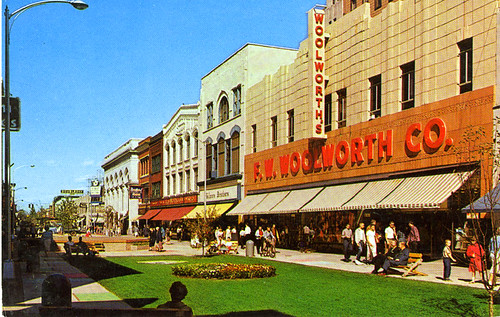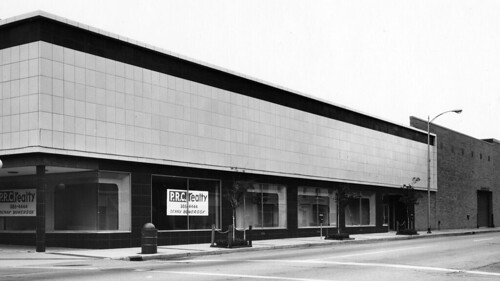Guardian "Walking the City" series
In advance of today's World Carfree Day ("World Carfree Day: Saturday September 22nd), the Guardian has been running a series of articles called "Walking the City."
I wanted to have a feature on applying pedestrian streets principles in DC, not for long streets called pedestrian malls, but for a block or two, here and there around the city, where it can work.
In the past, I've been negative when pedestrianized districts have been proposed in DC (e.g., "How to f*** up 17th Street NW in Dupont Circle," 2007) but now I realize I was too much influenced by the first pedestrian mall I ever saw, in Kalamazoo in 1986, and its relative failure.

It did not look this vibrant when I saw it. This postcard is from the 1960s.

Kalamazoo Pedestrian Mall in the 1980s, after the JC Penney closed.
I remember being very surprised at the Dutch ThinkBike workshop in 2010, when one of the facilitators pointed out DC doesn't have any pedestrianized areas and shouldn't that be something to be addressed?
-- "Reprint from 2010: The Dutch ThinkBike workshop in DC,"
In the US, pedestrian malls that are successful tend to be in college towns, but not exclusively such as Third Street in Santa Monica, places with a preponderance of people without cars. In the region, Charlottesville and Winchester have pedestrian malls that remain successful, albeit with some property vacancies.

Charlottesville
For pedestrian malls to be successful, they need to be well designed, well managed, well programmed, and perhaps most importantly, highly visited because empty spaces don't attract visitors they repel them.
-- "Now I know why Boulder's Pearl Street Mall is the exception that proves the rule about the failures of pedestrian malls," 2005
-- "K Street: Last of the pedestrian Malls," Sacramento Business Journal, 2009
But the thing I had to get over is thinking about this in terms of long pedestrian malls or large pedestrian districts like in Essen, Hamburg, or Liverpool, and more in terms of one or two blocks, here and there, where it makes sense in the local context.
And building on and extending from there. Like what I suggested a few weeks ago for Silver Spring, Maryland.
-- "Making "Downtown Silver Spring" a true open air shopping district by adding department stores
And no, I am not talking about "shared spaces" where pedestrians mix with cars.
More on this next week.
Labels: air quality, car culture and automobility, civic architecture, civic engagement, pedestrian malls, pedestrian planning, sustainable mobility platform, transportation planning



0 Comments:
Post a Comment
<< Home